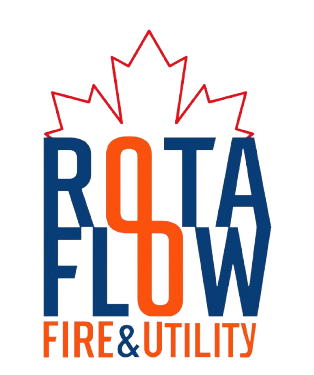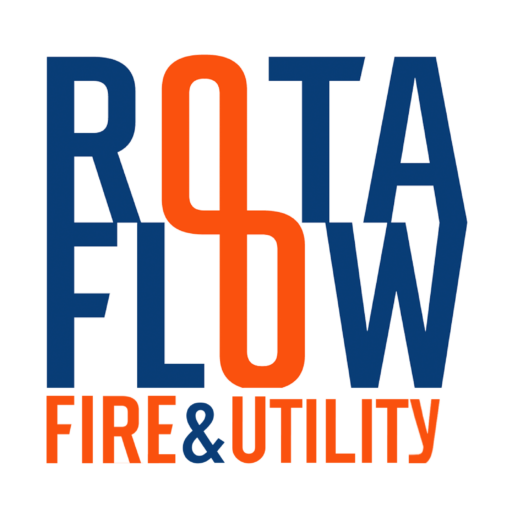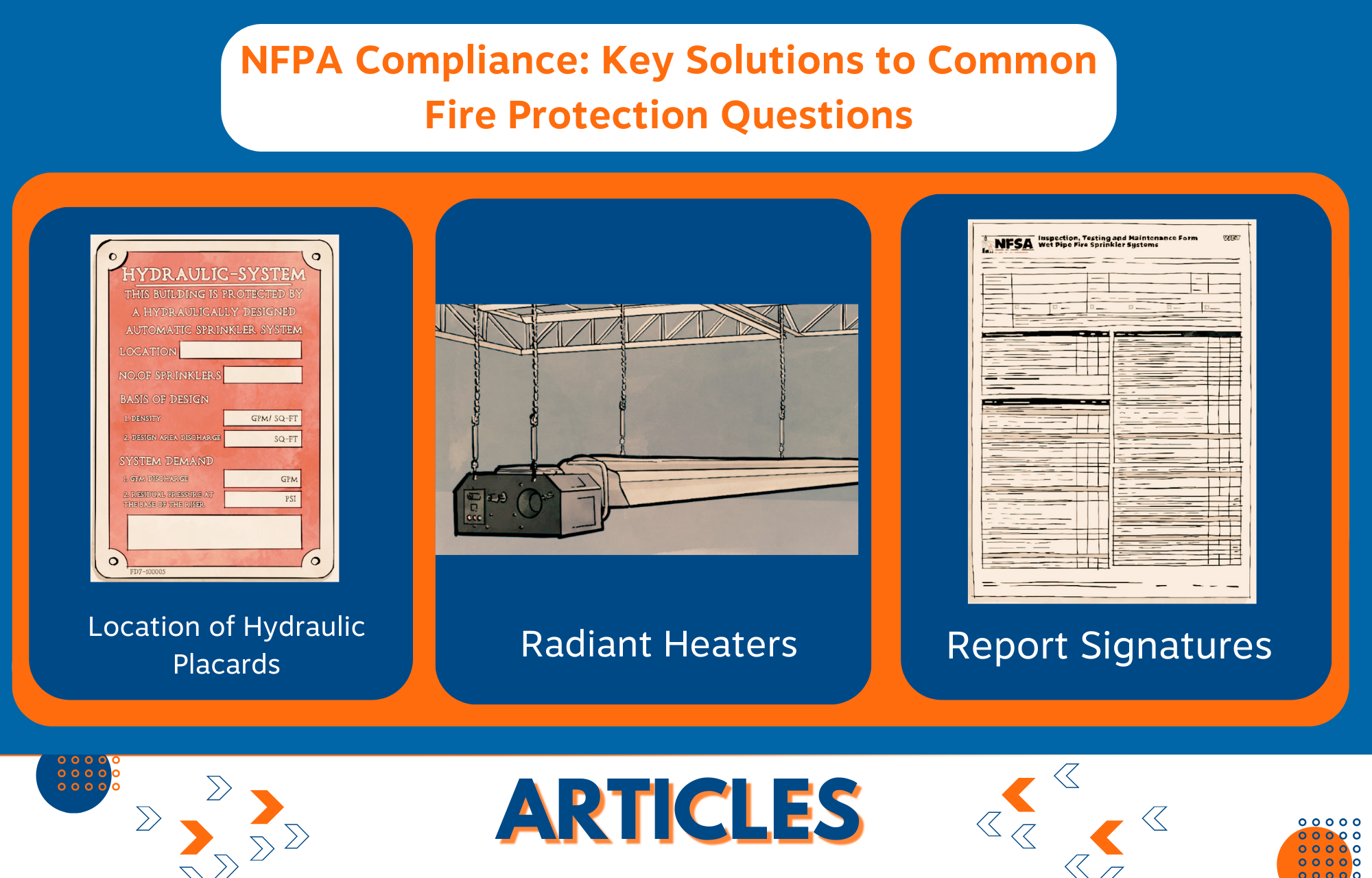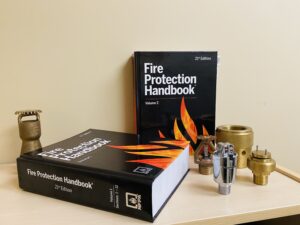Summary: It is true that the requirements for minimum temperature ratings and separation distances between sprinklers and radiant tube heaters have not changed with the latest editions of NFPA 13. However, it should be noted that the table (Table 9.4.2.5(a) in the 2019 edition of NFPA 13) that addresses sprinkler temperature ratings based on distance from heat sources now includes an entry titled “unit heater and radiant heater.”
This is a minor modification from the 2016 edition, when the article was only labelled “unit heater” and radiant heaters were not discussed. This makes it clear that the same standards are intended to be used by the NFPA 13 committee.
1. Location of Hydraulic Placards. Description- The hydraulic placard sign should be situated in the main riser chamber, as previously agreed. On a recent project (multi-story structure with floor control valves), a hydraulic placard was needed for each level. Question 1. The 2019 version of NFPA 13 does not specify the placement of a hydraulic placard at each floor control valve. According to Section 28.5.2, this notice must be shown at the alarm valve, dry valve, and other relevant locations.
Answer:The latest versions of NFPA 13 mandate a hydraulic data plate for each system and intended area. The 2013 version mandated floor control valves for most multi-story structures. If each level has a floor control valve assembly (with a control valve, check valve, main drain and flow switch), it is termed a separate sprinkler system.
The placement of the hydraulic data indicator varies across NFPA 13 versions, leading to misunderstanding. From 2013 to 2019, the sign has to be placed near the applicable design area’s alarm or dry pipe valve (2013, Section 25.5.1). In the 2022 version, the wording was updated to require the sign to be put at all system risers, floor control assemblies, and alarm valves (2022, Section 29.4.2). The 2022 edition allows the AHJ to advise on sign specifications and exclude new signs. For example, if the water supply, design, and danger are all the same, the AHJ may allow the sign to be removed or duplicated on each level.

2. BFP Test Valve Electrical Supervision. Description- There is no need to electrically monitor the test line's backflow test valve. Its main purpose is to stop water from returning to the system in the first place. This is a mechanical operation that doesn't need electrical monitoring. Question 2. Does the backflow test valve on the test line need to be electrically monitored?
Answer: Generally, no. Understanding valve monitoring involves determining whether closing the valve will interfere with the fire protection system’s functioning. If the backflow test valve is only used for testing and does not affect the water supply to the fire protection system, no supervision or tamper switch is needed.
Check local codes since they may have more stringent monitoring requirements than norms. In the US, the International Building Code, Section 903.4, takes precedence above NFPA 13, Section 16.9.3.3.1. The IBC does not need a tamper switch. However, if one is installed, it must be an electric switch rather than a chain and lock, as authorised by NFPA 13.
3. Means to Perform Forward Flow Test on Backflow Preventor Assembly. Description- It is not permitted to conduct a forward flow test after a backflow preventer employing a tee with a cap, as stated in NFPA 13, Section 16.14.5.1.1 (2019 version). In order to guarantee accurate testing and system performance, the code necessitates that test connections be appropriately built. Question 3. Is it allowed to do a forward flow test using a tee with a cap following a backflow according to NFPA 13, Section 16.14.5.1.1, 2019 edition code requirements?
Answer: A tee with a cap on the backflow preventor’s system side does not fulfil NFPA 13, 2019 edition, Section 16.14.5.1.1 testing standards.
A procedure for downstream of all backflow prevention valves for forward flow testing at a minimum flow rate of the system demand, including hose allowance if necessary, is required by NFPA 13, 2019 edition, Section 16.14.5.1. Section 16.14.5.1.1 specifies that the arrangement described in Section 16.14.5.1 must be serviceable without needing the owner to alter the system for testing.
To test the back-flow preventers forward flow, remove the 6 inch cap and attach hoses. Modifying the system to complete the test does not fulfil Section 16.14.5.1.1’s criteria. To perform the forward flow test, the owner would need to alter the system by removing and replacing the 6-inch cap.
Please note that the 2022 edition has more criteria for this problem. According to Section 16.14.5.1.1, a 2 1/2 inch (65 mm) hose valve should be installed downstream of the backflow prevention valve for every 250 gpm (950 L/min) of system demand, including any appropriate hose allowance. Forward flow tests may be performed using other methods as long as they do not need any adjustments and are appropriate for system requirements.
4. ESFR and Automatic Heat Vents. Description- This section says that Early Suppression Fast-Response (ESFR) sprinklers cannot be used in buildings with automated heat or smoke vents unless the vents have a high-temperature rated, standard-response mechanism. Question 4. Could you explain the automated heat vents mentioned in Section 12.1.1.2 of the 2013 NFPA 13?
Answer: This section covers automated heat and smoke vents in buildings protected by ESFR sprinklers. Sprinkler systems, particularly ESFR systems, may not work well when heat and smoke vents allow heat to escape, potentially activating extra sprinklers to suppress a fire.
Fire rules require smoke and heat vents to have at least 360-degree Fahrenheit fusible connections. This permits the sprinkler system to function, and if temperatures rise, vents may open for exhaust.
5. Sprinkler Temperature in Same Compartment. Description- The issue is whether it is acceptable to put sprinklers with various temperature ratings—ordinary and intermediate—in the same room or area, as long as no particular heat sources influence the temperature. The risk is that combining different temperature ratings might result in uneven sprinkler activation. Question 5. Is it OK to install sprinklers with a combination of ordinary and intermediate temperatures in the same compartment without particular heat sources?
Answer: “Yes” is the response. It is permissible to employ both temperature values in the same compartment. NFPA 13 previously required the use of ordinary temperature-rated sprinklers throughout buildings, with intermediate or higher-temperature sprinklers used in areas with high ambient temperatures near heat sources. The 2010 version of NFPA 13 made it possible to use sprinklers rated for intermediate temperatures throughout an occupancy. This was done to account for high ambient temperatures during warmer months, as well as potential changes in the position of heat-producing equipment like HVAC diffusers.
Section 8.3.2.1 of NFPA 13 (2016 edition) specifies that ordinary and intermediate rated sprinklers must be used throughout a building, not only ordinary or intermediate. It is also permissible to combine ordinary and intermediate temperature sprinklers inside the same compartment. In the 2019 edition of NFPA 13, an annexe note clarifies that it is acceptable to install ordinary-temperature sprinklers, intermediate-temperature sprinklers, or a combination of the two.
Sprinklers in the same compartment may have both ordinary and intermediate temperature, but they must all have the same sensitivity. For instance, sprinklers in a compartment must have either rapid or standard response. The answer types cannot be blended in the same compartment.
6. Report Signatures. Description- The topic is whether NFPA 25 mandates that both the customer or owner's representative and the technician sign sprinkler inspection reports. This is to ensure that all parties recognise and verify the inspection findings as well as the sprinkler system's condition. Question 6. Is it required by NFPA 25 to have both the customer/owner's representative and the technician sign sprinkler inspection reports?
Answer:
NFPA 25 does not need anyone’s signature. Section 4.3.2 outlines standards for inspection, testing, and maintenance.
- The procedure (inspection, test, or maintenance)
- The organisation doing the task
- The frequency.
- Results and Date.
- The name and contact information for the qualified person(s) carrying out the activity.
Consult with legal counsel to avoid potential pitfalls with contracts, ITM records, and other legal documents.

7. Balcony Protection by Standpipe Fire Hose. Description- The topic is whether residential buildings must equip their balconies with fire hoses linked to the standpipe system. It also asks how to establish the proper distance between the fire hose connection and the balcony, which requires measurement to guarantee that fire hoses can reach all places. Question 7. Do residential buildings need to cover their balconies with fire hoses from the standpipe system? For instance, how do you calculate or measure the distance between the fire hose connector and the balcony?
Answer: According to NFPA 14, Standard for the Installation of Standpipe and Hose Systems, (2013) Section 7.3.2.2, the hose connection must cover the most distant area of the “floor”.
The travel distance is calculated on the floor or walking surface, following the natural course from the hose connection and allowing for a 12-inch space around corners and barriers.
If the travel distance is excessive, the local Authority Having Jurisdiction (AHJ) may mandate extra hose connections.The International Building Code (IBC) defines a floor as the space inside the inner perimeter of outside walls, and considers balconies to be horizontal projections. However, the standard does not define floor area.
8. Fire Pump Curves and Hydraulic Calculation Software. Description- The inquiry concerns whether it is appropriate for hydraulic software to display negative pressure measurements on its graphs when these readings do not adhere to NFPA 20 regulations. This relates to whether or not the disparities point to an issue or code violation. Question 8. Our hydraulic software's graphs display negative pressure readings that do not align with NFPA 20. Is it acceptable?
Answer: It’s okay to do this, yes. No, NFPA 20 has no instances of this kind of circumstance.
The sprinkler system demand and the available water supply are compared on the water supply graph. There are circumstances in which the demand for the sprinkler system, which includes the pressure generated by the fire pump, is represented by negative pressure figures and does not need a positive pressure from the municipal water supply.
This is typical of warehouse structures. For instance, a warehouse’s design includes a fire pump to satisfy the system’s need for the facility’s storage. However, there is also a light-risk office space. It is feasible that the fire pump may generate much greater pressure on its own without any positive pressure from the municipal water supply if it is sized for both the storage sprinkler system demand and the light hazard office area requirement. In this instance, the needed water pressure from the city would be a negative pressure figure when comparing the system demand to the water supply.
9. Water Tanks and Automatic Refill. Description- Given that there is no automatic system in place to replace a 150,000-gallon water storage tank in a distant location, the issue is whether it is feasible to manually oversee the replenishment of the tank. This entails taking into account the work and difficulties involved in manually maintaining the water level in the tank. Question 9. A 150,000-gallon water storage tank in a remote location without an automated water supply replenishment is part of a project. Is it possible to complete this situation manually?
Answer: Yes, it may be feasible to fill by hand. Except for “Break Tanks,” which are addressed in Section 14.5 of NFPA 22, there is no general need in the 2023 edition (or earlier) for the fill mechanism to be automated.
It is true that Section 14.4 mandates a permanent tank fill connection that is linked to a dependable water source (14.4.1) that has the capacity to fill the tank in eight hours (4.2.1.4). These sections do not specify that the fill be automated; instead, they stipulate that a persistent fill connection is necessary.
According to Section 14.4.1.1, if there is a plan for manually replenishing the tank that is approved by the relevant authorities and there is no permanent water supply available, then there is no need for the connection. NFPA 22 merely specifies that the manual fill must be authorised by the AHJ; it offers no instructions on how this should be done. Having the water trucked in to fill the tank is one possibility.
It is important to remember that the tank must always be maintained full (14.4.3) and that in the event that the tank’s capacity is insufficient to fulfil the fire protection requirement (14.4.1.2), the NFPA 25 impairment procedures must be followed.
Although there are several passages in NFPA 22 that suggest otherwise, the document does not explicitly indicate that an automatic fill is not necessary. For instance, the phrase “Where a separate fill pipe is used, automatic filling shall be permitted” appears in Section 14.4.7.
Furthermore, a dependable automated filling system could be able to minimise the tank’s size. According to Section 4.1.6, the tank must be sized so that the system demand is satisfied for the necessary amount of time by the stored supply plus dependable automated replenishment.
10. Manual Dry Standpipe Testing. Description- Only automated wet standpipes seem to be subject to the 2020 version of NFPA 25's need for a flow test every five years in the case of manual dry standpipes. Question 10. What further tests, including hydrostatic testing, are necessary for a manual dry standpipe?
Answer: NFPA 25’s 2014 version mandated flow testing for Class I and III standpipe installations.
The 2017 version was modified to solely mandate flow testing for automated standpipes, including class II. The editions of 2020 and 2023 saw no changes to this.
All manual standpipe systems (except from those that combine manual wet standpipe and automatic sprinkler) and semi-automatic standpipe systems must undergo a hydrostatic test at a minimum of 200 psi, or 50 psi if the typical operating pressure exceeds 150 psi, including the fire department connection. For instance, the hydrostatic test would be necessary at 210 psi for a semi-automated standpipe with a typical operating pressure of 160 psi. Keep in mind that this differs from the acceptance test specifications stipulated in Section 12.6 of NFPA 14, 2024 edition, for new installations.
11. Cloud Ceilings. Description- As stated in Section 8.15.24 of the 2016 edition of NFPA 13, sprinklers may be excluded from above the cloud ceiling. A ratio of aperture width to ceiling height up to one may be found in Table 8.15.24.1. Question 11. Is it possible to exclude sprinklers from above a ceiling cloud using table 8.15.24.1 if the opening width to ceiling height ratio is more than one? The cloud has a ceiling height of 81⁄2 feet and a maximum openness of 12 inches.
Answer: No, when the opening width to ceiling height ratio is more than one, Table 8.15.24.1 cannot be used.
There are two methods described in NFPA 13 for handling cloud ceilings. First, you must abide by Section 8.15.24. However, it seems from your description that Table 8.15.24.1 is not met by the cloud ceiling. Furthermore, as stipulated in Section 8.15.24.1 (1), the openings need to fulfil requirements 1 and 2. This also doesn’t seem to fulfil Section 8.15.1.2.1.2, which specifies that a gap “longer than 4 feet (1.2 m) shall not have a width greater than 8 inches,” since it has a 12-inch-wide aperture.
The situation in which these clouds don’t fit the requirements in Section 8.15.24 represents the second method for handling them. In this case, you would handle every cloud ceiling panel as if it were a barrier preventing the danger from being reached by the sprinkler discharge. Depending on the kind of sprinkler utilised, the relevant obstruction requirements from Chapter 8 would be applicable. This would mean that each cloud ceiling panel in the scenario would need to have a sprinkler built underneath it since a sprinkler has to be placed beneath any impediment that is wider than four feet.
12. Radiant Heaters. Description- Sprinklers from ESFR will be used in a warehouse project. The building has radiant heating systems. We've been informed that the radiant heating systems negate the need for the separation from heat source requirement (Section 8.3.2.5 in the 2016 NFPA 13). Question 12. Exists a section in the most recent editions dedicated to ESFR and heater locations?
Answer: It is true that the requirements for minimum temperature ratings and separation distances between sprinklers and radiant tube heaters have not changed with the latest editions of NFPA 13. However, it should be noted that the table (Table 9.4.2.5(a) in the 2019 edition of NFPA 13) that addresses sprinkler temperature ratings based on distance from heat sources now includes an entry titled “unit heater and radiant heater.”
This is a minor modification from the 2016 edition, when the article was only labelled “unit heater” and radiant heaters were not discussed. This makes it clear that the same standards are intended to be used by the NFPA 13 committee.

Courtesy: Roland Asp, CET, TechNotes



